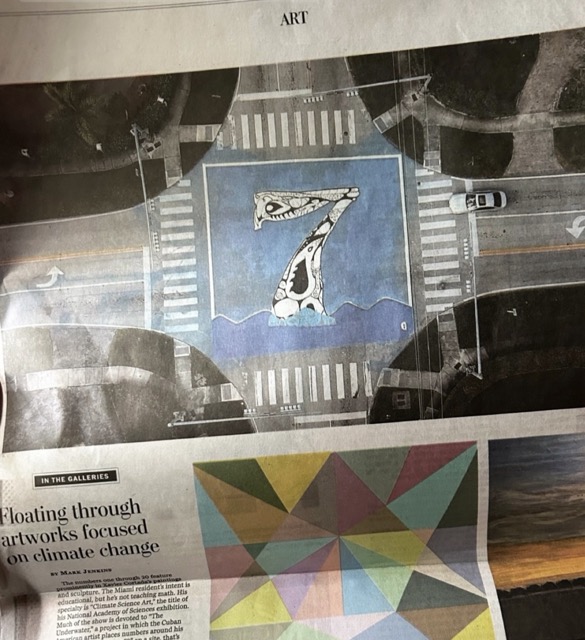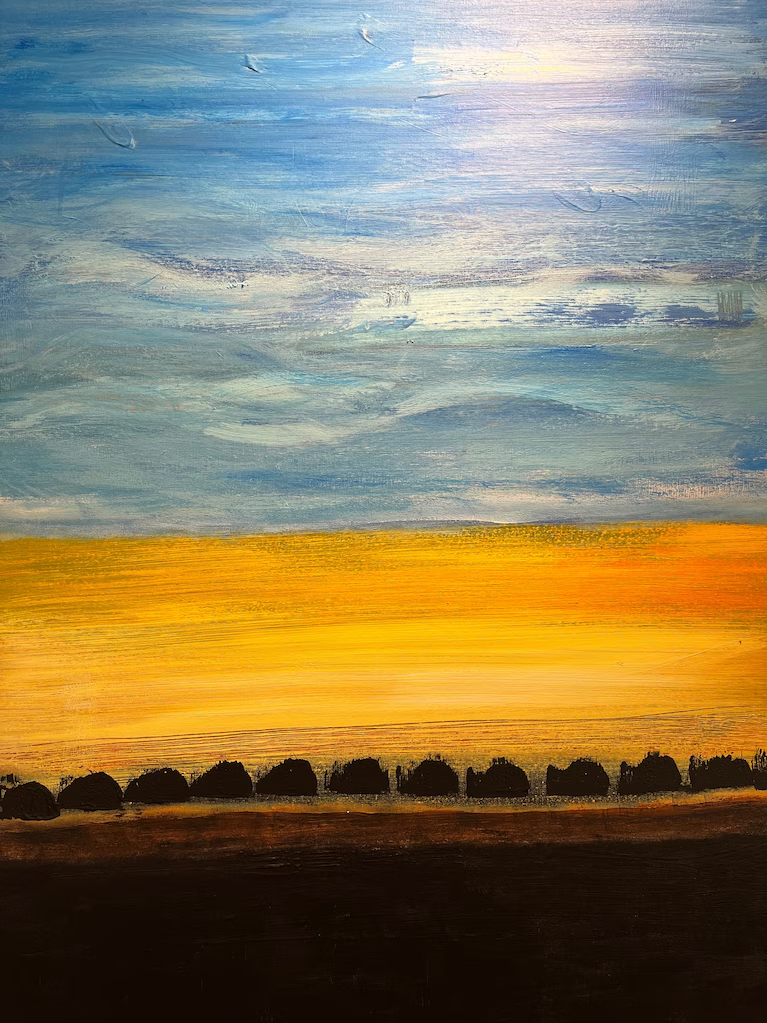

Xavier Cortada’s “Underwater HOA Elevation Drive: 7,” an aerial photograph of paint on asphalt, in his show “Climate Science Art” at the National Academy of Sciences. (Xavier Cortada Foundation)
Review by Mark Jenkins
August 23, 2024 at 6:00 a.m. EDT
Cortada’s investigation of sea level change began with a sojourn in Antarctica in 2006-2007. That was followed by a 2008 trip to the Arctic on a Russian icebreaker. In both regions, he made art with paint and melting ice. Examples of such paintings are on exhibit alongside photographs of the artist’s Antarctica installations. These include a circle of 24 shoes, each representing the people in one of the planet’s time zones, and 51 flags that mark the shifting locations of the South Pole on a moving ice sheet during the years that (as of 2006) humans had inhabited the region.
All the projects were carefully plotted, and included elements of ritual — as does “The Underwater,” whose concrete markers are baptized with seawater at their dedications. But Cortada sometimes leaves things to chance: His Arctic pictures were made by putting ice and pigment on paper and letting the paintings create themselves as the ice liquefied. He’s open to natural processes and revelations.
The artist sees a direct link between thawing ice caps and Miami’s likely fate. His paintings of elevation numbers, which can be large enough to fill the intersection of a major thoroughfare, depict the digits as partly submerged. The number sculptures, made of environmentally sustainable concrete, incorporate organic details that suggest coral reefs. As beautiful as they are foreboding, the concrete numerals mimic aquatic forms in anticipation of an underwater future.
Xavier Cortada: Climate Science Art Through Dec. 31 at the
National Academy of Sciences, 2101 Constitution Ave. NW.
cpnas.org/exhibitions-events. 202-334-2415.

Geometry & Calligraphy

“More Neo Geo #3” by William Olexik in the group exhibit “Geometry & Calligraphy.” (Pars Place Iranian American Community Center)
Islamic decorative arts, which typically do not depict people or animals, underpin most of the works in “Geometry & Calligraphy,” a group show at Pars Place Iranian American Community Center. But Persian miniatures, small paintings that do depict living creatures, are also an influence on some of the pictures. Both traditions are characterized by exquisite detail and such opulent materials as metallic leaf and crushed gems.
Moonlike gold orbs dominate two bold pictures by Laila Kokabi that suspend white lettering over deep green backgrounds. Such gold accents are common in the show, employed in script or intricate patterns that suggest ornate buildings and decorative tiles. Emphasizing the primacy of divine inspiration, Anahita Razavi’s tilelike abstraction is titled “Geometry of God.”
Dariush Vaziri adds depth, and a bit of color, to a gray-and-black calligraphic abstraction by stretching black strings horizontally across it, and by disrupting these suspended lines by using red threads to pull some of them upward. The most strictly geometric compositions are William Olexik’s hard-edge “Neo Geo” paintings, whose facets suggest cut jewels.
Only a few participants portray animate beings. A flying horse rendered in rough white and black brushstrokes is the subject of Azadeh Tavakoli’s expressionist painting, while Mahnaz Samsani Weldy portrays a Sufi dancer with kinetic looseness. Small passport-like photos are submerged in Maryam Rassapour’s colorful abstractions, which include calligraphic accents. Most unlike the other works are Ali Faramarzi’s drawings, in which the decorative motifs serve as backdrops for entwined couples. The line drawings are far from explicit, yet carry an unexpected erotic charge.
Courtney Adair Applequist
In her quest to represent motherhood, Courtney Adair Applequist burrows all the way to the microscopic level. One piece in the local artist’s “(M)other,” at Joan Hisaoka Healing Arts Gallery, is a dark, near-abstract rendering of cellular growth made mostly of handprints. Projected on the adjacent wall is changing text that includes the refrain, “dividing, dividing, dividing.” (The words are by Jane LeCroy, the video by Reed Griffith.)
Applequist depicts many sorts of division, cultural as well as physical. Several pictures are large paintings of women’s faces in extreme close-up, mostly black but with areas that break down into blocks of prismatic color. Another portrait splinters a drawing of a mammoth visage across 60 pages of an antique book of marital advice, arranged in a tight grid. The face appears contained and constrained by old rules.
Birds, a motif of Applequist’s show last year at Adah Rose Gallery, appear in two of these works. The bigger one centers on drawings of faces on ragged sheets of corrugated cardboard that fray at each side. The ragged edges are purposeful, because they lead to flocks of birds, cut from cardboard and affixed to the wall in ascending swoops. While most of “(M)other” observes women in caged circumstances, this installation takes flight.
Courtney Adair Applequist: (M)other Through Sept. 8 at Joan Hisaoka Healing Arts Gallery, 1632 U St. NW. joanhisaokagallery.org. 202-483-8600.
Art in the Summer

“Summer Safari in Kenya” by Wendy Plotkin-Mates, part of the group exhibit “Art in Summer.” (Watergate Gallery & Frame Design)
Shall we compare the artworks in Watergate Gallery’s “Art in Summer” to an August day? The warmest one is a vast Maryanne Pollock painting that arrays birds, flowers and ornamental diamonds and mandalas on a sunny yellow backdrop. The local artist is known for decorating tents, intended as spaces for contemplation, with similar motifs. This banner can’t actually be entered, but it is immersive nonetheless.
Many of the other eight contributors do offer three-dimensional works. Robin Bell’s 3D-printed pedestals hold plants or reflective gazing balls. Neon specialist Craig Kraft’s abstract watercolors are flat, but backlighted by glowing tubes beneath them. Joe Dailey’s ceramics, made in the Japanese raku mode, curve elegantly while bending light with their gleaming glazes.
Painters Angela Iovino and Wendy Plotkin-Mates simulate depth in landscapes that sometimes cross over to pure abstraction. Doug Schulte and Rudiger Haugwitz add actual depth, the former with collaged elements and the latter with bold use of metallic leaf and pigments. The most dynamic picture is by Serena Martinez, whose multicolored paint-blot is vigorously cross-hatched. Its mottled reds and purples aren’t particularly summery, but they do radiate heat.
Art in the Summer Through Sept. 28 at Watergate Gallery, 2552 Virginia Ave. NW. watergategalleryframedesign.com. 202-338-4488.
See original article at https://www.washingtonpost.com/entertainment/art/2024/08/23/art-gallery-shows-dc-area/